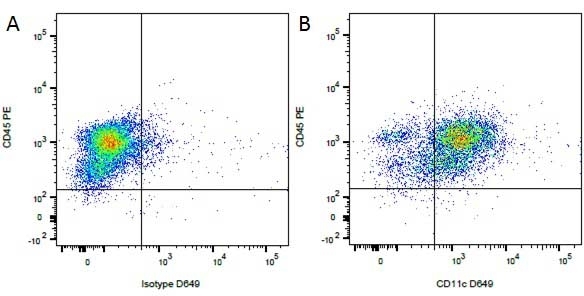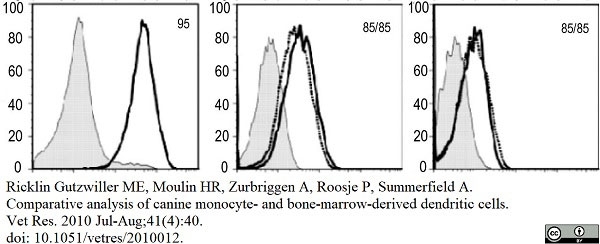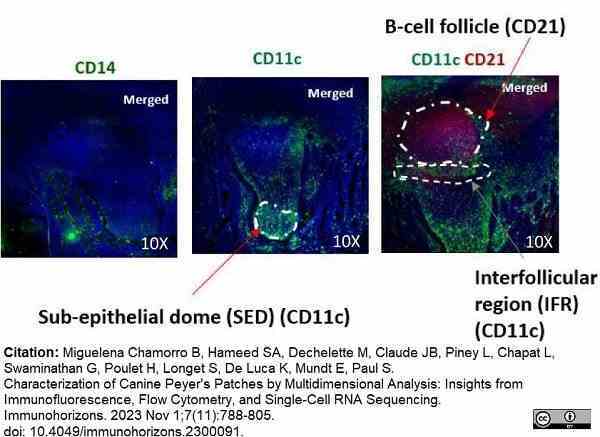CD11c antibody | CA11.6A1




Mouse anti Dog CD11c
- Product Type
- Monoclonal Antibody
- Clone
- CA11.6A1
- Isotype
- IgG1
- Specificity
- CD11c
| Mouse anti Dog CD11c antibody, clone CA11.6A1 recognizes the canine CD11c cell surface antigen, a member of the alpha integrin family. Canine CD11c is expressed by monocytes, granulocytes and by dendritic cells. Mouse anti Dog CD11c, clone CA11.6A1 immunoprecipitates proteins of approximately 95 kDa, corresponding to the common β chain of the CD11/CD18 heterodimer and ~150 kDa, the CD11c; chain from canine leukocyte preparations (Danilenko et al. 1992) |
- Target Species
- Dog
- Species Cross-Reactivity
-
Target Species Cross Reactivity Hooded Seal Raccoon - N.B. Antibody reactivity and working conditions may vary between species.
- Product Form
- Tissue culture supernatant - liquid
- Preservative Stabilisers
- 0.1% sodium azide
- Regulatory
- For research purposes only
- Guarantee
- 12 months from date of despatch
Avoid repeated freezing and thawing as this may denature the antibody. Storage in frost-free freezers is not recommended.
| Application Name | Verified | Min Dilution | Max Dilution |
|---|---|---|---|
| Flow Cytometry | |||
| Immunohistology - Frozen 1 | |||
| Immunohistology - Paraffin | |||
| Immunoprecipitation |
- 1The epitope recognised by this antibody is reported to be sensitive to formaldehyde fixation and tissue processing. Bio-Rad recommends the use of acetone fixation for frozen sections.
- Flow Cytometry
- Use 10μl of the suggested working dilution to label 106 cells or 100μl whole blood
| Description | Product Code | Applications | Pack Size | List Price | Your Price | Quantity | |
|---|---|---|---|---|---|---|---|
| Mouse IgG1 Negative Control | MCA928 | F | 100 Tests |
|
Log in | ||
| List Price | Your Price | ||||||
|
|
Log in | ||||||
| Description | Mouse IgG1 Negative Control | ||||||
References for CD11c antibody
-
Danilenko, D.M. et al. (1992) Canine leukocyte cell adhesion molecules (LeuCAMS): characterization of the CD11/CD18 family.
Tissue Antigens 40: 13-21. -
McDonough, S.P. and Moore, P.F. (2000) Clinical, hematologic, and immunophenotypic characterization of canine large granular lymphocytosis.
Vet Pathol. 37: 637-46. -
Affolter, V.K. and Moore, P.F. (2002) Localized and disseminated histiocytic sarcoma of dendritic cell origin in dogs.
Vet Pathol. 39: 74-83. -
Catchpole, B. et al. (2002) Generation of blood-derived dendritic cells in dogs with oral malignant melanoma.
J Comp Pathol. 126: 238-41. -
Sanchez, M.A. et al. (2004) Organ-specific immunity in canine visceral leishmaniasis: analysis of symptomatic and asymptomatic dogs naturally infected with Leishmania chagasi.
Am J Trop Med Hyg. 70: 618-24. -
Ibisch, C. et al. (2005) Functional canine dendritic cells can be generated in vitro from peripheral blood mononuclear cells and contain a cytoplasmic ultrastructural marker.
J Immunol Methods. 298: 175-82. -
Mathes, M. et al. (2006) Evaluation of liposomal clodronate in experimental spontaneous autoimmune hemolytic anemia in dogs.
Exp Hematol. 34: 1393-402. -
Isotani, M. et al. (2006) Efficient generation of canine bone marrow-derived dendritic cells.
J Vet Med Sci. 68: 809-14.
View The Latest Product References
-
Wang, Y.S. et al. (2007) Characterization of canine monocyte-derived dendritic cells with phenotypic and functional differentiation.
Can J Vet Res. 71: 165-74. -
Liu, C.C. et al. (2008) Transient downregulation of monocyte-derived dendritic-cell differentiation, function, and survival during tumoral progression and regression in an in vivo canine model of transmissible venereal tumor.
Cancer Immunol Immunother. 57: 479-91. -
Bird, R.C. et al. (2008) An allogeneic hybrid-cell fusion vaccine against canine mammary cancer.
Vet Immunol Immunopathol. 123: 289-304. -
Kang, J.W. et al. (2008) Soluble factors-mediated immunomodulatory effects of canine adipose tissue-derived mesenchymal stem cells.
Stem Cells Dev. 17: 681-93. -
Wang, Y.S. et al. (2008) Cytokine profiles of canine monocyte-derived dendritic cells as a function of lipopolysaccharide- or tumor necrosis factor-alpha-induced maturation.
Vet Immunol Immunopathol. 118: 186-98. -
Schwartz, M. et al. (2008) Selective CD11a upregulation on neutrophils in the acute phase of steroid-responsive meningitis-arteritis in dogs.
Vet Immunol Immunopathol. 126: 248-55. -
Ricklin Gutzwiller, M.E. et al. (2010) Comparative analysis of canine monocyte- and bone-marrow-derived dendritic cells.
Vet Res. 41: 40. -
Pai, C.C. et al. (2011) Immunopathogenic behaviors of canine transmissible venereal tumor in dogs following an immunotherapy using dendritic/tumor cell hybrid.
Vet Immunol Immunopathol. 139 (2-4): 187-99. -
Figueiredo, M.M. et al. (2013) Expression of Toll-like Receptors 2 and 9 in cells of dog jejunum and colon naturally infected with Leishmania infantum.
BMC Immunol. 14: 22. -
Larsen, A.K. et al. (2013) Entry and elimination of marine mammal Brucella spp. by hooded seal (Cystophora cristata) alveolar macrophages in vitro.
PLoS One. 8: e70186. -
Qeska, V. et al. (2014) Canine distemper virus infection leads to an inhibitory phenotype of monocyte-derived dendritic cells in vitro with reduced expression of co-stimulatory molecules and increased interleukin-10 transcription.
PLoS One. 9 (4): e96121. -
Heinrich, F. et al. (2015) Immunophenotyping of immune cell populations in the raccoon (Procyon lotor).
Vet Immunol Immunopathol. 168 (3-4): 140-6. -
Paoloni, M. et al. (2015) Defining the Pharmacodynamic Profile and Therapeutic Index of NHS-IL12 Immunocytokine in Dogs with Malignant Melanoma.
PLoS One. 10 (6): e0129954. -
Constantinoiu, C.C. et al. (2015) Mucosal tolerance of the hookworm Ancylostoma caninum in the gut of naturally infected wild dogs.
Parasite Immunol. 37 (10): 510-20. -
Stokol, T. et al. (2015) Alkaline phosphatase is a useful cytochemical marker for the diagnosis of acute myelomonocytic and monocytic leukemia in the dog.
Vet Clin Pathol. 44 (1): 79-93. -
Heinrich, F. et al. (2015) Passage-dependent morphological and phenotypical changes of a canine histiocytic sarcoma cell line (DH82 cells).
Vet Immunol Immunopathol. 163 (1-2): 86-92. -
Bonnefont-Rebeix, C. et al. (2016) Characterization of a novel canine T-cell line established from a spontaneously occurring aggressive T-cell lymphoma with large granular cell morphology.
Immunobiology. 221 (1): 12-22. -
Bird, R.C. et al. (2019) Autologous hybrid cell fusion vaccine in a spontaneous intermediate model of breast carcinoma.
J Vet Sci. 20 (5): e48. -
Miguelena Chamorro, B. et al. (2023) Characterization of Canine Peyer's Patches by Multidimensional Analysis: Insights from Immunofluorescence, Flow Cytometry, and Single-Cell RNA Sequencing.
Immunohorizons. 7 (11): 788-805. -
Mason, N.J. et al. (2021) Development of a fully canine anti-canine CTLA4 monoclonal antibody for comparative translational research in dogs with spontaneous tumors.
MAbs. 13 (1): 2004638.
- Synonyms
- Integrin Alpha X Chain
- RRID
- AB_322942
MCA1778S
If you cannot find the batch/lot you are looking for please contact our technical support team for assistance.
Please Note: All Products are "FOR RESEARCH PURPOSES ONLY"
View all Anti-Dog ProductsAlways be the first to know.
When we launch new products and resources to help you achieve more in the lab.
Yes, sign me up


